A display of geometic and pictorial patterned dhurries adorns the walls of weaver Tejsibhai Dhana Marwada in the village of Sanjotnagar, near Bhuj in Kutch,. Woven into the kharad (Sindhi word for carpet) on the most basic and ancient of looms, are the stories of these weavers’ lives and experiences. Some of these narrative pieces were initiated by Carole Douglas for her exhibition Zindagi jo Vanat – The Weave of Life. Tejsi explained to us the stories depicted in the pieces. One tells of the Marwada Meghwal community migration. They came to Kachchh from Marwad in Rajasthan about 600 years ago, hence their name Marwada which accords a sustained sense of identity and community. They were traditional farmers and breeders of cattle, sheep, goats and camels. They came to Kuran village situated between the Great Rann and the Black Hills in northern Kachchh because here the water was sweet and the land was green. They built a temple to their main saint Ramdev Pir, believed to be an incarnation of Lord Krishna and also worshipped by neighbouring Rabaris and Ahirs as well as Muslims (hence the title Pir). Partition ruptured the the strong social and economic connections that the Marwads shared with Sindh in what is now Pakistan, something that the old men still lament. ‘Life was simple. Our animals thrived and prospered’.
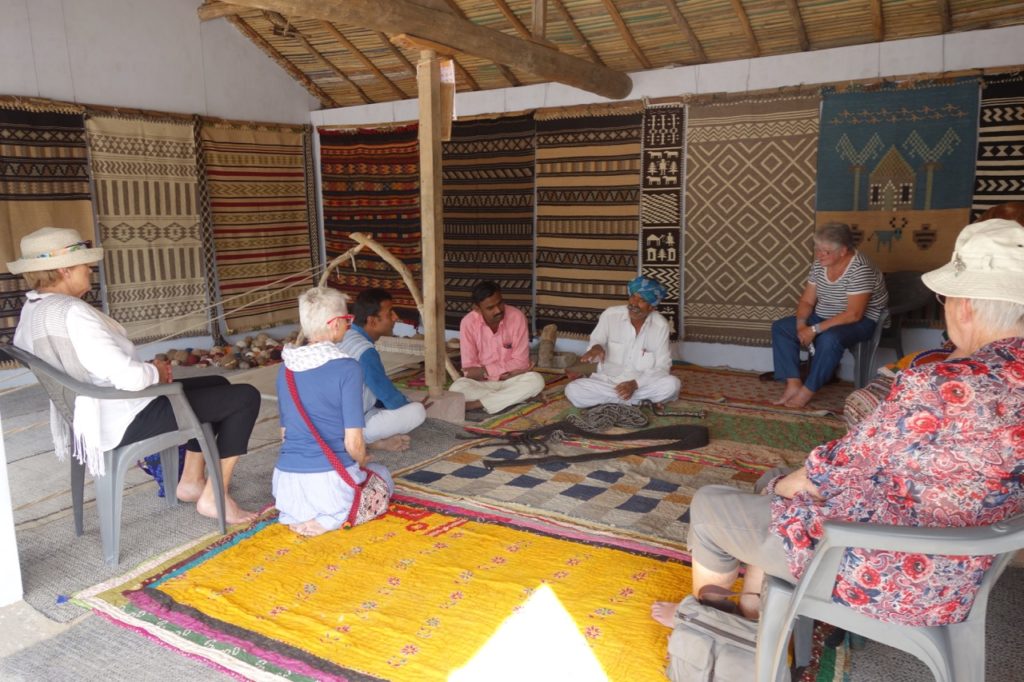
When you think of Kachchh weaving, kharad weaving is unlikely to be the first thing that springs to mind. It has not flourished as much as the ‘shawl’ or traditional wool weaving (now also cotton, silk and other fibres too) more widely practiced in Kachchh. Kharad weaving is currently being practiced by only two families, a decrease from 10 in the 1990s and probably many more before that. The sedenterisation of the nomadic shepherding communities that provided the wool for the kharads, as well as the centralisation and mechanisation of spinning were the main causes of this decline. As well as carpets, traditional items included camel bags. Tejsi is also a master at camel belt making, made not on a loom, but with no tool at all – using the ply-split braiding technique. This technique too is slowly dyeing out as the cheaper plastic and leather belts replace the traditional wool braided ones.
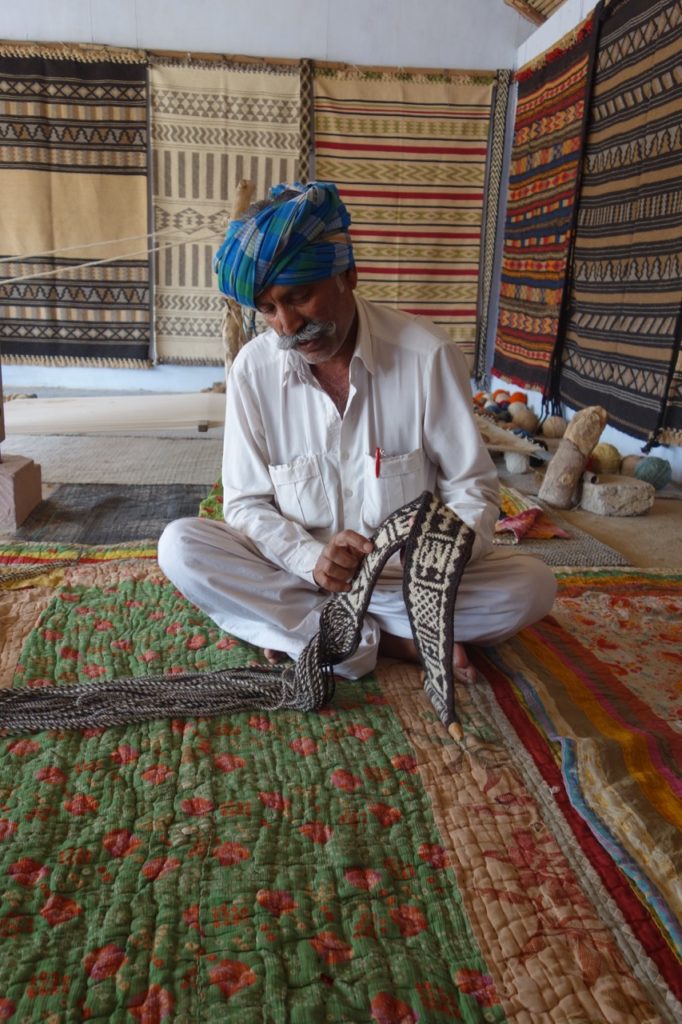
Another trio of rugs depict each of the homes Tejsi has inhabited (see the exhibition catalogue here). The first being in his birthplace of Kuran village, where Tejsi and his family had to leave after the earthquake of 2001. They lived temporarily on a hillside near Kukma, where his children went to school, and was conveniently positioned near Bhujodi where he could sell his work. The rug depicts his wife Sajna boiling milk to make chai, his daughter collecting water to wash the cups for chai to be made for visitors, as well as workshops that they had built to hosue the looms. After a factory had been built on the family’s grazing land, Tejsi was offered a house by an NGO on a new settlement of Sanjotnagar near Kukma. With the help of some money Carole had been given, Tejsi bought some land opposite the house and built a workshop. So the third rug depicts the ‘new home of weaving’ along with his whole family: himself, his wife Sajanaben, his son Samatbhai, daughters Devaben and Jetaben and youngest son Hirabhai.
Tejsi taught his son Samat weaving and it was he that demonstrated the craft to us on our visit. I was amazed that Samatbhai had actually recognised me from when I had visited back in 2008, ‘you bought one of the recycled plastic bags!’ he said, which I still have today of course. The recycled bags were made as part of the project, exhibition and conference ‘New Voices New Futures’ which had taken place in Ahmedabad.
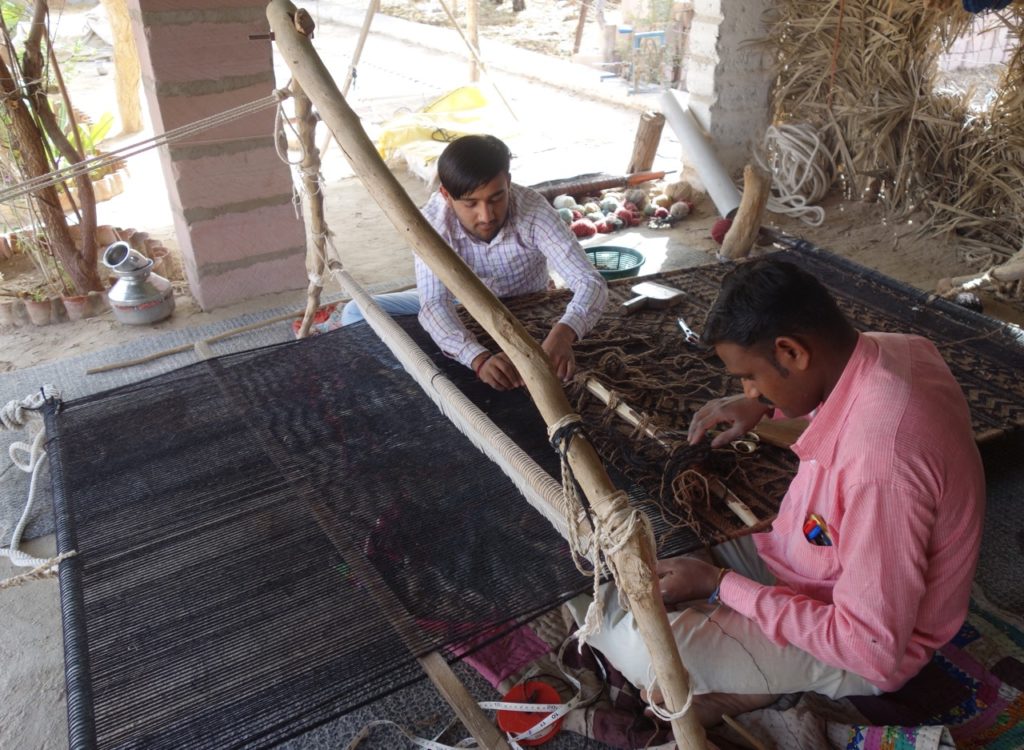
The Marwada community brought weaving with them from Rajasthan. They traditionally weave with undyed sheep, goat and camel wool for essential items for the community’s own use such as camel udder bags, tiffin bags and sacks for carrying grain which were tightly woven so that they were water and insect proof and no grain could escape. Tejsi’s father is the last person who is still spinning goat hair which he does every day for the family. Camel wool comes from the Sodha people in Jura village and sheep wool from Rajasthan. Traditionally kharads were used for warmth on floors and for special gatherings of people and meetings. People would bring their rolls of carpets for an important occasion to give comfort as well as to show respect. They last a long time due to the toughness of the fibres.
Other rugs depict the themes of monsoon, farming, marriage, festival, the earthquake and ‘restoring balance in nature’ in response to the rapid increase of polluting factories in Kachchh. The colours in these rugs have been created using natural dyes.
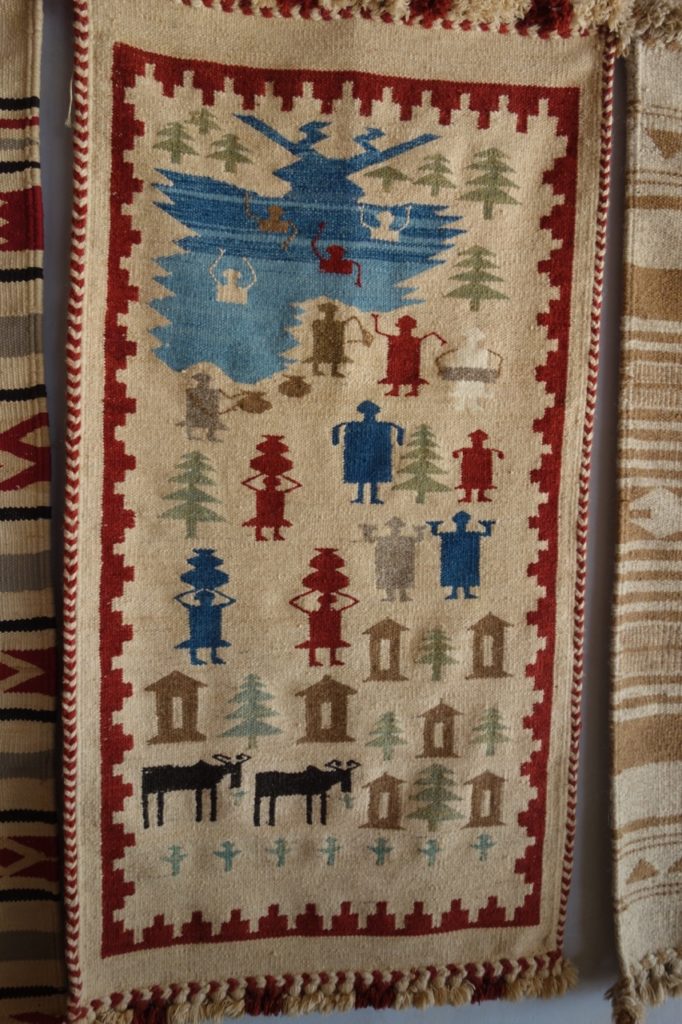
On another visit to Kachchh I had met Dayabhai Sumar who was weaving and selling his work in the Hiralaxmi Crafts Park in Bhujodi. Dayabhai still lives in Kuran, and so having the chance to sell from the Crafts Park was useful for him. However, it was disappointing to see that he was often having to lower his prices because people were not willing to pay what he quoted. He was not over-charging, but some members of the general public were either not interested, aware of the craft’s story or just didn’t hold the value in the products that they deserved.
Fortunately, the rugs are finding their way into a lucrative luxury market. Khamir have been working with the weavers to develop new designs and colour combinations and facilitating market linkages. The rugs are easily adaptable to a variety of styles, such as the classic Scandinavian style, as evidenced by Finnish brand Tikau. Dayabhai weaves bold geometric monochrome kharads for Australian brand KeepSake. Thus ancient skills, techniques and materials can be comfortably compatible with a contemporary market.
The Zindagi jo Vanat exhibition catalogue can be found here:
Desert Traditions, run by expert tour leader, and long-time collaborator with Kachchh artisans, Carole Douglas regularly leads textile and craft tours to Kachchh and other parts of India and the Americas. Coming up this year are a tour to Santa Fe and Mexico, in July to August, and Rajasthan in November. See the website for more details.
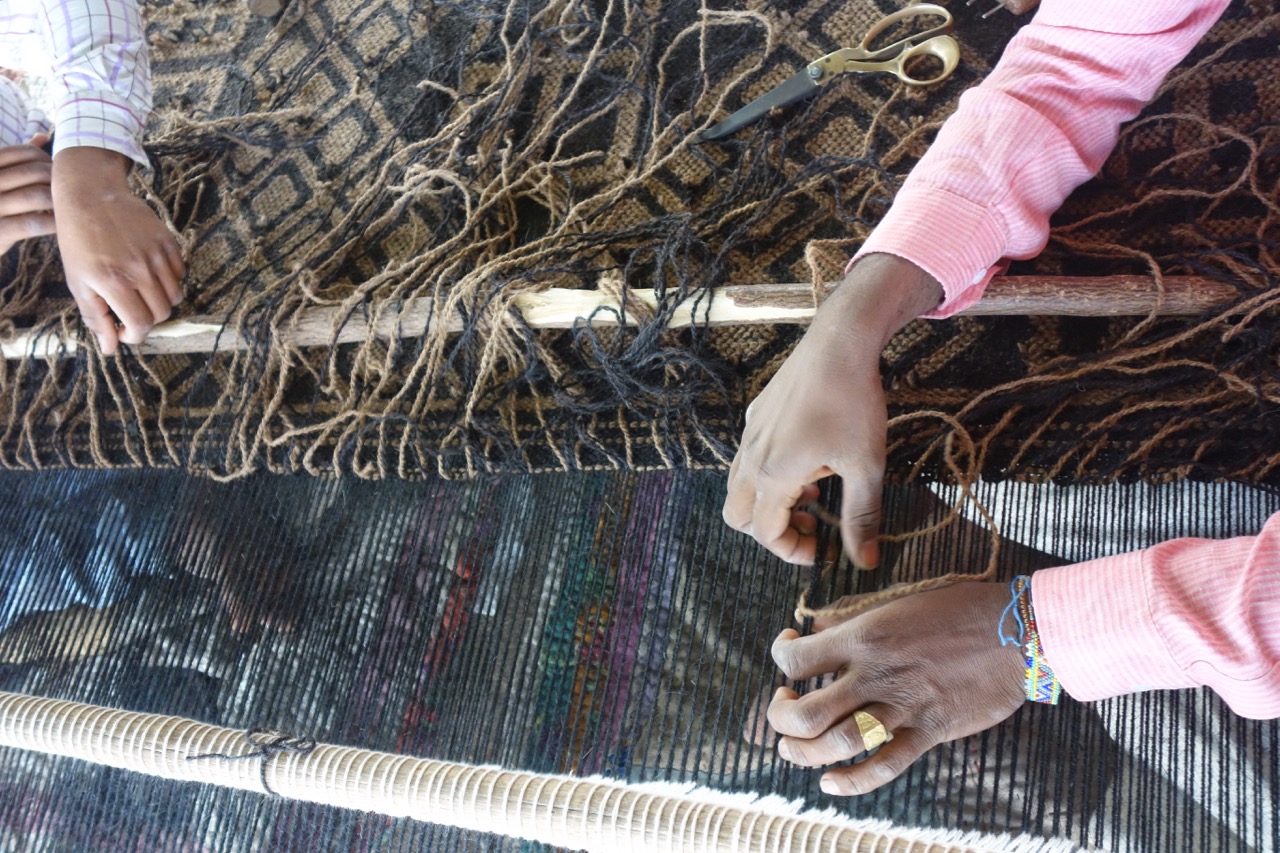
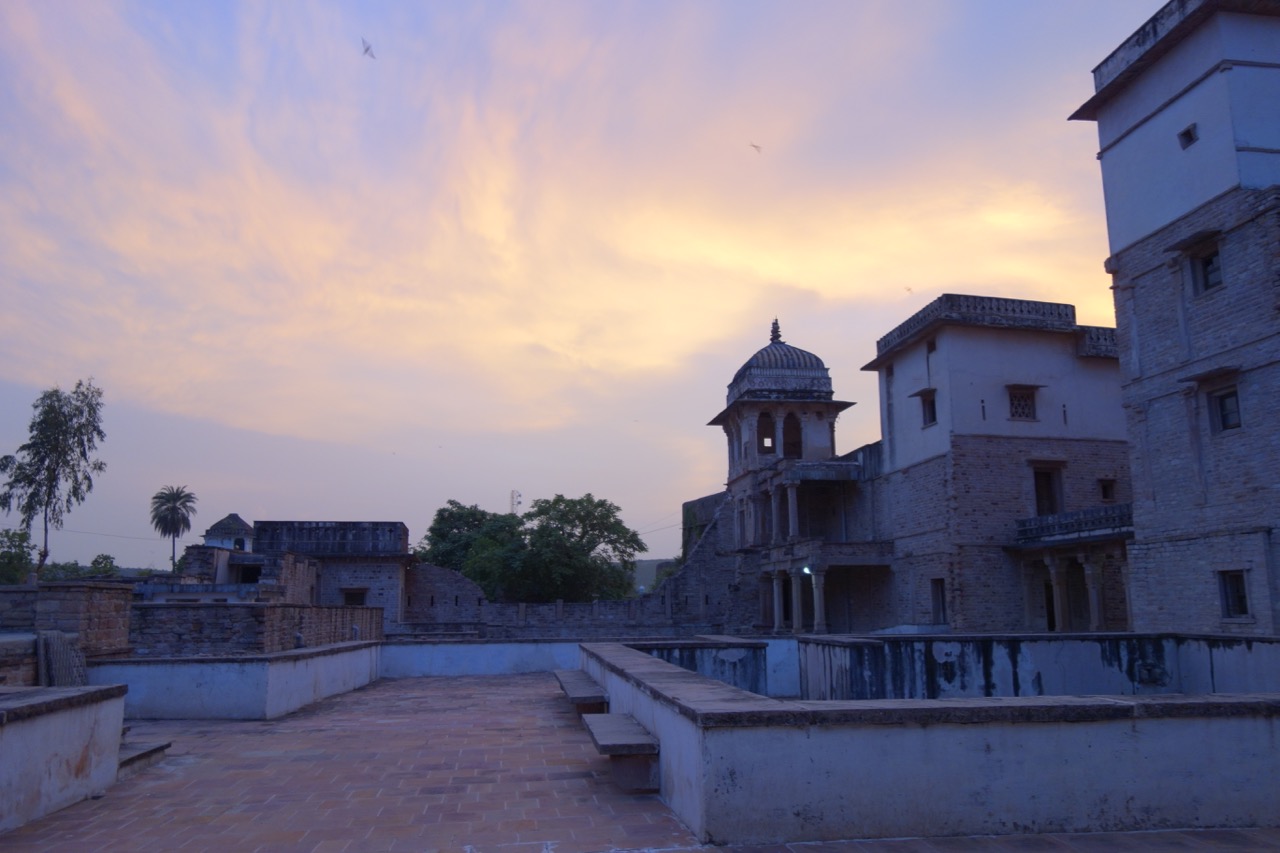



One Comment
Samridhhi Sondhi
There are further changes to the present condition of these Kharad weavers. With the number finally decreasing to one practicing Kharad weaver in the region and just one off tracks of dholavira.